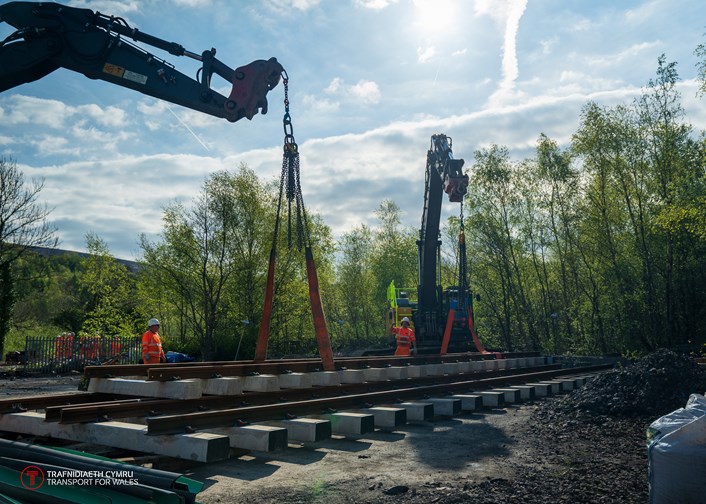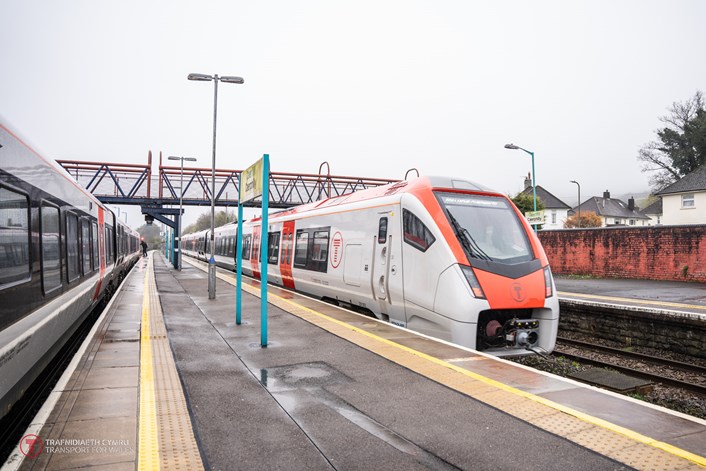04 Apr 2023
The South Wales Metro is a once in a generation opportunity to transform transport for the people of South East Wales. It will improve peoples’ lives and make sustainable travel the easiest way to travel. When funding for the historic South Wales Metro project was confirmed in 2018, an initial £738m was made available to deliver the once-in-a-generation transformation of the Core Valley Lines (CVL) into a modern, integrated network of rail, bus and active travel to improve connectivity and make sustainable travel easier across South Wales.
At the time no-one could have predicted what the next five years would bring and the unprecedented impact of the COVID-19 global pandemic, in addition to the impact of Brexit and the on-going global trends in workforce and building material availability and cost as a result of the war in Ukraine, means we’ve had to adjust both the delivery plans and expected final budget of the project.
Cost projections
Following the extensive re-evaluation exercise carried out by the TfW project team and AIW, we now anticipate the final cost of the South Wales Metro project to be circa £1bn. The predicted increase is a result of the expected cost rises outlined below.
| Item | Material Cost / Inflation | COVID-19 & Brexit | Infrastructure Constraints | Total |
| % Allocation of increase to AFC | 37% | 34% | 29% | 100% |
| Cost | £113.4m | £104.2m | £88.9m* | £306.7m |
What we’ve been doing
Faced with the external challenges outlined above, the project team has focused on realigning our programme based on the most deliverable timescales, and maximising cost efficiency.
We have done this by working collaboratively with our infrastructure delivery partners through our Craidd Alliance, and with additional scrutiny and independent advice from a number of industry leading experts.
The key areas of focus for the teams are currently the commissioning of the brand-new trains for the Metro, securing key funding streams and control over the overall cost and delivery timeline of the project.
We’ve also changed the approach to the infrastructure (tracks, signalling, electrification etc) to deliver a key section of upgraded track ahead of other changes, to ensure we can deliver the new trains as quickly as possible, whilst protecting the required key deliverables to maintain the European Regional Development Funding as far as reasonably practical.
A number of alternative options have been thoroughly considered to ensure cost and project impact are reduced.
As part of this we’ve strengthened our project controls and oversight of the programme and integrated the management of the programme delivery with Amey Infrastructure Wales (AIW).
This includes increased independent layers of governance, additional programme control measures, director-level accountability for delivery throughout the supply chain, and further advanced purchase of construction materials to secure their availability. Other measures include;
- A weekly executive-level steering group with representation from TfW and Amey’s CEO, Managing Director, and Business Directors.
- A dedicated workstream focusing on integrated management of the infrastructure, rolling stock and organisational readiness for entry-into-service of the rail system.
- Enhanced infrastructure monthly business management reporting.
- Significant advanced procurement of specialist construction materials to protect programme timescales.
- Independent review and challenge to programme delivery by leading industry experts.
- Review of programme performance by TfW’s Major Projects Committee every quarter, chaired by one of the Board’s Non-Executive Directors. This in-depth review covers all aspects of the CVL programme.
External factors
Below is a further explanation of the expected increases in costs due to the external factors listed above.
Supplier material cost increases/availability:
- Increased global demand in the construction sector, combined with the multiple and complex impacts of the pandemic alongside logistic issues, have resulted in unprecedented shortages, delays and ultimately, increased prices of materials and labour across the economy.
- Utilising data from the Building Cost Information Service (BCIS) of the Royal Institution of Chartered Surveyors (RICS), the updated programme cost takes into account and caters for material cost trends from 2020 and 2021, assuming no further demonstrable increase during 2022.
- Data from BCIS shows a 40 year high in construction costs in November 2021. As an example, the price movement in Q1 to Q3 that year for Timber, Steel and Basic Metals had increased by 78.9%, 77.4% and 24.8% respectively.
- With approx. 7,200 tonnes of bare steel for the Overhead Line Equipment (OLE) programme, to include time-related costs, this element in terms of raw material cost alone prior to fabrication has increased by c.£6.8m (as of April 2022).
COVID-19
- The impact of COVID-19 has caused productivity losses, triggering programme delays, in-turn resulting in cost increases. On-site productivity has been compounded further by uncertainty of workforce availability, social distancing measures and material delays.
- The time prolongation experienced on CVL, is similar to that of other UK major infrastructure projects. Both HS2 and Hinkley Point have and continue to experience productivity loss, due to workforce shortages, poor transfer of design information due to remote working and late material deliveries resulting in project completion delays.
- The construction sector’s reliance on the flow of global material supply chains continues to cause disruption, and although some shortages have been addressed, pinch points in the domestic supply chain are also continuing to impact productivity; with delays being reported in the arrival of steel, timber and aggregates.
Brexit
Since January 2021, the relationship between the UK and the EU has been governed by the Trade and Cooperation Agreement (TCA). While the deal is a more favourable option than a ‘no deal’ scenario, leaving the EU single market has still impacted construction in a number of ways:
- Impact on exports: Although the UK has secured tariff-free trade with its EU neighbours, this only applies to ‘originating’ products i.e. products that originate from the EU, proving problematic for businesses with complex supply chains; in CVL’s case, signalling equipment.
For example, the time it takes to get some of critical data chips increased from five to 16 weeks in January 2021, resulting in a direct impact to the delivery of a new signalling system.
- Impact on workforce: The freedom of movement between the UK and EU ended in January 2021. Under new immigration laws, EU migrants are now subject to a points-based system for visa eligibility. This has had an impact on some programme resource.
Infrastructure constraints
Some infrastructure delays have been caused by incomplete or unavailable information about some assets which have resulted in additional design, survey or engineering work.
There have also been some unforeseen infrastructure challenges, for example the existing National Grid power supply was not robust enough in the Rhymney Valley and has required additional Overhead Line Equipment (OLE) for the new trains.
Discovery of a number of significant statutory utilities requires major diversions. This has delayed the installation of the Overhead Line system and new track, across both the Aberdare and Treherbert lines in particular. TfW is engaging with utility providers and monitoring the extensive, ongoing diversions of c.10km’s from the railway estate into the local highway.
In the Cathays area of Cardiff an MRI scanner at Cardiff University means we can’t install OLE due to electromagnetic compatibility issues, which has required a change of design to the system.
Design constraints
Changes to design programme due to multiple reasons:
- Resource availability – We’re competing against other UK major Infrastructure programmes, exacerbated by a post-COVID construction boom.
- Programme – availability/validity of input data impacting design commencement/completion.
- Design Deliverables – changes to design to be completed resulting from system architecture development, design maturity, internal and external influences.
Inflation
Inflation has been revaluated from tender contract value to present day rates, contributing towards the overall updated programme delivery cost.
The current budget assessment has been calculated using trending data from UK Government Transport Analysis Guidance (TAG). In summary, a weighted average of CPI and RPI has been used to assess and apply the assumed inflation on Costs to Complete (CTC).
A high-level summary can be evidently seen with inflation levels being at 1.3% in December 2019, to 10% today (March 2023).
The way forward
The project team are working incredibly hard to deliver the infrastructure upgrades required to introduce the new trains – Class 231s, Class 756s and Class 398s – across the CVL network, while also making sure this work supports the increase in service frequency through future timetable changes.
A review of available options has been completed and in order to reduce costs and delays to new trains arriving onto the network, we’re now prioritising the signalling and electrification of a key section of track upon the CVL network that effectively becomes the ‘test track’.
For this delivery method the area of the CVL network referred as TAM (Treherbert, Aberdare & Merthyr) is split into two parts, being:
- TAM A – Radyr to Pontypridd, Aberdare and Merthyr; and,
- TAM B – Treherbert.
Due to the requirement to sequence signalling commissioning across the wider GB network, coupled with limitations on signalling, design and construction resource, it is not feasible to safely deliver both TAM and Cardiff – Rhymney (CAR) works concurrently.
Summary
Despite the unforeseeable challenges presented to the project team over the last three years, we remain committed to delivering the transformational South Wales Metro project while also providing the best possible value for money for the people of Wales.
Cost increases and project delays are of course disappointing, but not uncommon for a hugely ambitious project of this scale. The Metro team however have managed these normal challenges well but have been significantly impacted by programme delays due to the pandemic and much higher inflation pressures which were not foreseen at planning stage of this project.
We’ve recently entered the first of our brand-new South Wales Metro trains into service on to the Rhymney Line and this marked the beginning of an incredibly exciting period of change that will take place over the next few years. We have also now started taking delivery of the Metro Vehicles into the new Taff’s Well depot.








